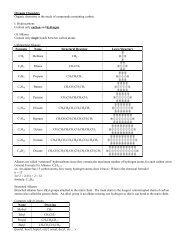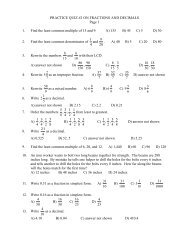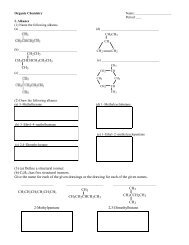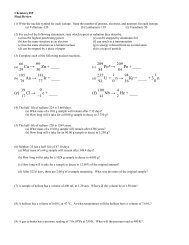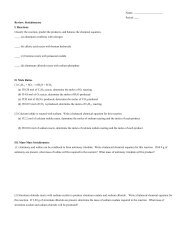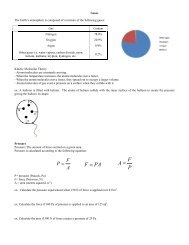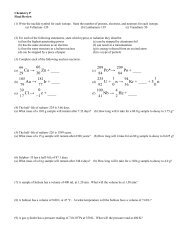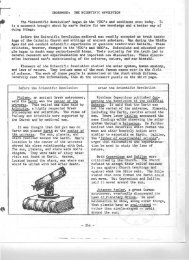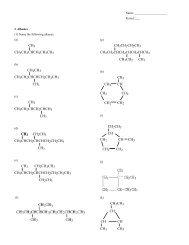- So Truman started off again all confident and excited – he had a program called the Fair Deal, which hehoped (but largely failed) to implement. The programs he did manage to get passed are as follows: Welfare/Relief – He extended minimum wage, extended Social Security coverage tothousands of people, passed a Housing Act, and passed the Agricultural Act of 1949, whichgave farmers 90% of the market price as supports. Civil Rights – He desegregated the military, appointed more blacks than ever to high offices,and created a President’s Committee on Civil Rights, which wrote what was to be<strong>com</strong>e theagenda for the movement in the <strong>com</strong>ing years – To Secure These Rights (1947). Displaced Persons Act – He passed an act to allow more refugees into the country.- However, his attempts to modify TH, pass a civil right bill, establish national health coverage, and get moremoney for education were blocked by the Republican Congress and special interests.- Truman’s most significant legacy, however, is that he strengthened the powers of the Presidency andmade many WWII agencies permanent – Atomic Energy Commission, Department of Defense, CIA.*The Eisenhower Presidency: Domestic Policies*- The Presidential Election of 1952 was a huge victory for war hero Dwight D. Eisenhower, who ranpromising to end the war in Korea and the whole virtuous-decent-friendly guy deal (“I Like Ike”). Besideswinning the presidency, the Republicans once again got both houses of Congress.- Overall, Eisenhower was a very popular President who relied a lot on the delegation of authority to cabinetmembers and didn’t have a clue what the heck was going on. This wasn’t such a big deal, b/c his years inoffice were about the status quo & conformity (“consensus mood”) where talk of reform became unpatriotic.- Both Democrats and Republicans alike avoided extremism (stuck with the center), and Eisenhower himselfcame up with “dynamic conservatism” – we can’t remove the New Deal, so we’ll live with it and try torepresent business and balance the budget anyway.- What did Eisenhower do during his first term? He built a canal (spur economic development in Midwest),amended the Social Security Act to add people, reformed taxes, and passed the Atomic Energy Act of1954, which gave private <strong>com</strong>panies the right to use nuclear power.- Eisenhower also changed policies regarding Native <strong>Am</strong>ericans. <strong>His</strong> policy of termination (1953) forced NAsinto <strong>Am</strong>erican culture by getting rid of reservations, ending tribal sovereignty and federal services, andmaking Indians subject to state laws. This was supposed to help states’ rights and lower costs, but it wasmainly motivated by land greed (as ever).- Although the Congressional elections of 1954 gave the Democrats control of both houses of Congress,Eisenhower was reelected in a landslide victory in the Presidential Election of 1956.*Eisenhower’s Second Term: Domestic Policies*- In his second term, Eisenhower faced rising costs (partially b/c of <strong>Am</strong>erica’s involvement globally) butended up going with deficit spending due to the military budget and three short recessions.- In 1958 Eisenhower faced further problems when Sherman Adams (the President’s chief aide) resignedunder suspicion of a scandal, and the Republicans lost big time in the 1958 Congressional elections. Then in1960 there was a recession, and the whole U-2 plane incident (more on that later).- Although Eisenhower was popular, in retrospect, he did avoid dealing with the major issues of poverty,urban decay, and civil rights – and he authorized CIA covert operations. Nevertheless, just before leavingoffice, he was eerily prescient in his warnings against the “military-industrial <strong>com</strong>plex.”*McCarthyism – The Red Scare Redux*- McCarthyism was a major problem in both the Truman and Eisenhower administrations, and can basicallybe summarized as mass hysteria and overreaction to the idea of the Communist threat. Anti-<strong>com</strong>munismhad already surfaced in the Red Scare in the early 1920s, and e/t the Communist Party grew during theDepression, the Cold War brought the whole anti-<strong>com</strong>munist deal back big time.- Anyhow, here’s how anti-<strong>com</strong>munism began under Truman… Investigations of US Gov’t Employees: Truman helped begin the circus in 1947 by orderinginvestigations in the loyalty of employees of the US gov’t. This bred a whole atmosphere of fear and accusations ran rampant – in addition to theHollywood Ten in the movie industry, teachers, professors, and union leaders were alltargeted by the gov’t and by each other. This was especially harmful to the Unions. Alger <strong>His</strong>s Case (1949) State Department official Alger <strong>His</strong>s was accused by confirmed spyWhittaker Chambers of giving him classified documents. He was defended by Truman, andended up being convicted of perjury (not espionage).70
The Rise of McCarthy: It was in the midst of this whole deal that Senator Joseph McCarthystarted waving around his lists of confirmed <strong>com</strong>munists (they were really shopping lists,apparently). When this turned out to be a winning campaign issue, he stuck to it, and (for atime) seemed invulnerable. Julius & Ethel Rosenberg Case (1950): The Rosenbergs were accused of passing atomicsecrets to the USSR and were executed in 1953 (under Eisenhower). Internal Security (McCarran) Act (1950) – Targeted Communist front-group orgs. by forcingthem to register w/the gov’t and prohibiting them from holding defense jobs or traveling. Dennis et al. v. US (1951) – This SC decision upheld the Smith Act (1940), under which CPleaders had been arrested, due to the precedent set by Schenk v. US and the whole “clear andpresent danger” deal on free speech.- Then, under Eisenhower, there was more of the same. McCarthy continued his demagogic attacks, andEisenhower avoided confronting him lest it split the Republican Party. Additionally… Eisenhower attacked <strong>com</strong>munists himself though a 1953 executive order that allowed federalworkers to be dismissed as “security risks.” Communist Control Act (1954): This act, which received widespread bipartisan support,effectively made membership in the CP illegal. Army-McCarthy Hearings (1954): McCarthy finally fell after he attacked the US army. In thehearings, his vile treatment of witnesses and general obnoxiousness got him condemned forsullying the dignity of the Senate.- E/t McCarthy finally fell the hysteria had already taken its toll on the <strong>Am</strong>erican tradition of free speech.*The Civil Rights Movement*- The Cold War ended helping the civil rights movement b/c the US couldn’t make a big fuss about humanrights if it didn’t live up to its own ideals either. Additionally, the blacks that had migrated to the cities in WWIIbegan to control the political “balance of power” in the cities, and thus became important.- Subsequently Truman (in addition to genuinely believing in civil rights) had reasons to support it – in 1946,he created the President’s Committee on Civil Rights, which basically summed up the civil rightsmovement in their report To Secure These Rights (1947) – i.e. anti-lynching & anti-segregation laws.- Congress, however, didn’t act on the Committee’s suggestions – e/t Truman did in the end issue twoexecutive orders ending discrimination in the federal gov’t: one was on fair employment (Employment Boardof the Civil Service Commission), and the other desegregated the army (another <strong>com</strong>mittee to oversee).- A series of SC decisions also helped African <strong>Am</strong>ericans… NAACP’s Legal Defense Fund (Thurgood Marshall & Charles Hamilton Houston) workedagainst the separate but equal policies and got many blacks into universities. Smith v. Allwright (1944) – White-only Democratic Primaries in some states were outlawed. Morgan v. Virginia (1946) – No more segregation in interstate bus transportation.Shelley v. Kraemer (1948) – Outlawed agreements among white not to sell houses to blacks.Brown v. Board of Education of Topeka (1954) – The NAACP challenge to schoolsegregation succeeded on the grounds that separate facilities denied kids equal protectionunder the law (feeling of inferiority generated). Still, the SC didn’t order desegregation directlyuntil a year later, and even then there was no definite schedule, so Southern schools resisted.- In general, much of the South resisted the push towards civil rights – White Citizens’ Councils created toresist the school order – and Northern cities maintained a policy of segregation in terms of housing.- And the election of Eisenhower didn’t help as Ike ignored the issue (like he did everything else) hoping itwould gradually resolve itself – i.e. he objected to <strong>com</strong>pulsory federal segregation laws, thereforeencouraging white non<strong>com</strong>pliance to orders through his lack of leadership.- Then in Little Rock, Arkansas in 1957, the test of school integration occurred when whites tried to blockthe 8 black kids from entering Central High. In the end, Eisenhower was forced to send army paratroopers toensure their safety. In response, schools were closed for the following 2 years to avoid desegregation.- There was also the whole Rosa Parks and Montgomery Bus Boycott deal in 1955 – after Parks wasarrested, blacks under the leadership of MLK, a follower of Gandhi and advocate of non-violent protest,boycotted the buses until they were integrated – partially b/c of economic reasons and partially b/c of an SCdecision that declared the segregation laws unconstitutional.- Civil Rights Act (1957) – Created the US Commission Civil Rights to investigate discrimination, butproved ineffective.- As a result, blacks started a campaign of sit-ins in the South, which helped by giving their cause publicityand demonstrating the brutality of Southern Whites who attacked the non-violent protestors. The SNCC(Student Nonviolent Coordination Committee) was formed b/c of the sit-ins.*The 1950s: Comfort, Consumerism & Conformity*71
- Page 3 and 4:
Congregationalists (Puritans) - The
- Page 5 and 6:
- So the Restoration Colonies, form
- Page 7 and 8:
- So in England, where they were lo
- Page 9 and 10:
*Colonial Politics 1700-1750: Relat
- Page 11 and 12:
- Another ideology that was beginni
- Page 13 and 14:
- The Quebec Acts were passed aroun
- Page 15 and 16:
- So, by 1782, what had seemed to b
- Page 17 and 18:
on the economic side, since the gov
- Page 19 and 20: - Anyway, Congress had several ques
- Page 21 and 22: - Adams was still in the early Wash
- Page 23 and 24: *Political Factionalism and Jeffers
- Page 25 and 26: - Samuel Slater set up the first te
- Page 27 and 28: - Court rulings extended the powers
- Page 29 and 30: Revival, Reform and Politics during
- Page 31 and 32: - Anyhow, during his administration
- Page 33 and 34: TEXAS (Southerners) - Texas had bee
- Page 35 and 36: - Anyhow, Pierce’s total support
- Page 37 and 38: They had a smaller everything: smal
- Page 39 and 40: - The two Northern victories at the
- Page 41 and 42: - The result was the Fourteenth Ame
- Page 43 and 44: The Slaughter-House Cases (1873) -
- Page 45 and 46: in the arrest of 8 immigrant radica
- Page 47 and 48: case (1897 - ICC can’t set rates)
- Page 49 and 50: - The Populists prepared to run aga
- Page 51 and 52: - MOST IMPORTANTLY, though, was the
- Page 53 and 54: - So, what led the US to undertake
- Page 55 and 56: - The rebellion, led by Emilio Agui
- Page 57 and 58: - Still, Americans managed to turn
- Page 59 and 60: - So - the point of this episode? B
- Page 62 and 63: *Hoover’s Response*- Poor Herbert
- Page 64 and 65: - In FDR’s second term, however,
- Page 66 and 67: Dominican Republic - When we left i
- Page 68 and 69: World War II (1941 - 1945)*The Cour
- Page 72 and 73: - First of all, the 1950s were (for
- Page 74 and 75: peace w/Japan that ended occupation
- Page 76: - France wanted out, so at the Gene



